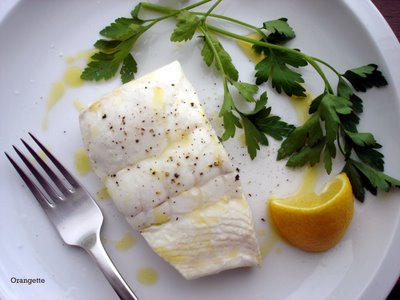In praise of poaching
Alright, people. I know what you’re thinking. Man, Molly’s sure been sucking down the butter these days. How about those fritters? Did Orangette get sponsored by a cardiologist or something? By all appearances, it’s been a regular fat fest at my place lately, with lipids on parade and Dessert Day everyday. But at the risk of silencing the ole Brown Butter Marching Band, I just want you to know—lest you should worry—that I have also been eating other things. In fact, just like Mom taught me, I can’t have dessert until I finish my dinner. My palate and I are very well trained.
And lucky for us, it’s May. The farmers’ markets are returning like so many migrating birds, staking out territory all over town. There are early baby greens and little pots of herbs to take home for planting. There are bundles of asparagus, piles of artichokes, and heads of cauliflower the size of softballs, curled into neat green bonnets of leaves. And then there is the sign of spring in Seattle—right up there, in my opinion, with Copper River salmon, cherry blossoms, and entire days of sunlight: the full-scale arrival of fresh Alaskan halibut. Even the janky grocery store in front of my apartment gets in on the excitement, unfurling a garish plastic sign that screams, “Alaskan Halibut is Here!” I mean to tell you, I love May.
To me, May means a welcome invitation to stop fussing with my food. For as much as I love winter’s languid braises and slow bakes, by the time spring rolls around, it’s a relief to sit down to a steamed artichoke, period, with maybe a pot of melted butter or homemade mayonnaise. Give me a spring salad, a fresh egg softly boiled, or a heel of coarse bread with butter, salt, and radishes. Or, in the case of this week, put me in front of the stove with a pan of water, garlic, and parsley, and hand me a piece of halibut.

Until a few nights ago, I never would have imagined myself stumping for poached fish, a concept that, for me at least, conjures up visions of pale, pasty, sickly-looking protein, sucked dry—perhaps vampire-style—of all color and nutrients. But this method, from Italy by way of Lynne Rossetto Kasper, has convinced me otherwise. It begins with a skillet of water seasoned with salt, crushed whole garlic cloves, and branches of Italian parsley, and it ends with a plump, snowy-fleshed piece of halibut, silky and fragrant. Along the way, the water is transformed into a salty, herbal broth—like seawater, but better—which infuses the fish and coaxes out its clean, sweet flavor. The garlic softens and mellows, ceding its sharp bite for round edges, winding itself gently around the fish and following it to the plate. Finished with a squeeze of fresh lemon and a slip of olive oil, this is no cafeteria-style fish. It’s more like spring in piscine form—and a very good prelude to dessert.
Poached Halibut with Sweet Garlic, Parsley, and Lemon
Adapted from Lynne Rossetto Kasper’s Weeknight Kitchen newsletter
The key to this preparation is Freshness, with a capital F. This dish is built to showcase the clean, delicate flavor of fresh fish and nothing less. Ask your local fishmonger—or even the fish guy at the grocery store, if that’s your best option—when he gets his deliveries, and save this recipe for those days. If you are in Seattle, get yourself—quickly!—over to Wild Salmon Seafood Market, where the fishmongers know their business and get halibut, fresh off the boats, once or twice a day. Likewise, make sure that you use a good, fresh head of garlic: there should be no green shoots poking from the top, and each clove should feel smooth, solid, and not the least bit spongy. And be sure to use an olive oil that, as Rossetto Kasper says, you would want to eat from a spoon. From there, it’s hard to go wrong.
4 cloves garlic, peeled and crushed
8 branches Italian parsley
1 tsp salt
Water
2 (~6-oz.) halibut fillets, skin removed, or another firm, white-fleshed fish such as cod, tilapia, or catfish
Additional Italian parsley branches, for garnish
2-4 juicy lemon wedges, for garnish
Good-tasting extra-virgin olive oil, for serving
Salt
Pepper
Place the garlic, Italian parsley, and salt in a 12-inch skillet or sauté pan. Add water to a depth of about 2 inches. Bring to a simmer, cover, and let cook for 5 minutes. It should smell very fragrant.
Meanwhile, measure the thickness of the halibut fillets. They will cook for 8 to 10 minutes per inch of thickness.
When the poaching liquid is ready, slip the fillets gently into the pan. Cook for 8 to 10 minutes per inch, adjusting the heat so that the liquid just trembles: it should only bubble a little, and very gently. To test the fish for doneness, make a small slit with a paring knife in the thickest part of the fillet: all but the very center of each piece should be opaque.
When each fillet is ready, use a slotted spatula to transfer it to a serving plate. Garnish the plates with sprigs of Italian parsley and lemon wedges. Serve immediately, allowing each eater to season their fish at the table with olive oil, salt, pepper, and freshly squeezed lemon.
Yield: 2 servings
Note: If you choose to halve this recipe, do not halve the amount of poaching liquid and aromatics. Halve only the amount of fish.


